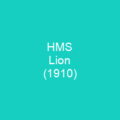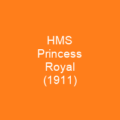The Lion Class: Royal Navy’s Splendid Cats
Imagine a fleet of ships that were not just vessels but symbols of power and innovation, the Lion class battlecruisers were such marvels. Built for the Royal Navy before World War I, these ships were nicknamed ‘Splendid Cats,’ a name that perfectly encapsulates their sleek design and formidable capabilities.
A Significant Improvement Over Their Predecessors
The Lion class battlecruisers represented a significant leap forward in naval technology. They were designed to be superior to the German Moltke class, with improvements in speed, armor, and gun size. These ships were not just faster; they were also better armed and armored, making them formidable opponents on the high seas.
Speed, Armament, and Armor
With a maximum speed of around 28 knots, these battlecruisers could outmaneuver their contemporaries. They were armed with 13.5-inch guns in four twin hydraulically powered gun turrets and sixteen BL 4-inch Mark VII guns primarily mounted in casemates. The armor protection was equally impressive, featuring a waterline belt up to 9 inches thick amidships and upper armor belts over the same length.

Key Battles and Roles
The first action for the Lion class was during the Battle of Heligoland Bight in August 1914. Here, they encountered crippled light cruiser Arethusa and sank her, then engaged and sunk Cöln. Their sister ship, Princess Royal, also played a role in this battle and later intercepted the German East Asia Squadron.
During the Battle of Dogger Bank in January 1915, the Lion class was part of Beatty’s squadron that engaged with Hipper’s German battlecruisers. The British forces were initially out of position but managed to engage effectively, with Princess Royal hitting Blücher at least twice.
In the Battle of Jutland on May 31, 1916, both Lion and Princess Royal played key roles in engaging the enemy ships. Despite suffering damage, they survived to rejoin the fleet later. The battle was a turning point, with both sides taking heavy losses but neither achieving a decisive victory.
Post-War Roles and Demise
The Lion class spent the rest of their lives on uneventful patrols before being put into reserve in 1920. By then, the terms of the Washington Naval Treaty of 1922 had come into effect, leading to their eventual sale for scrap.
Both ships were scrapped to meet the tonnage limitations of the treaty, marking the end of an era in naval history. The Lion class battlecruisers may have been overshadowed by later designs, but they left a lasting legacy as symbols of British naval might during World War I.
The Legacy of the Lion Class
Reflecting on the Lion class battlecruisers, one cannot help but wonder about their impact. They were not just ships; they were the embodiment of a nation’s resolve and technological prowess. Their story is a testament to the ingenuity and bravery of those who served aboard them.
The Lion class battlecruisers may have been part of history, but their legacy lives on in the annals of naval warfare. They remind us that even in the face of adversity, innovation and determination can shape the course of events. As we look back at these magnificent ships, we are reminded of the importance of preparedness and the enduring spirit of those who serve.
You want to know more about Lion-class battlecruiser?
This page is based on the article Lion-class battlecruiser published in Wikipedia (retrieved on November 29, 2024) and was automatically summarized using artificial intelligence.







